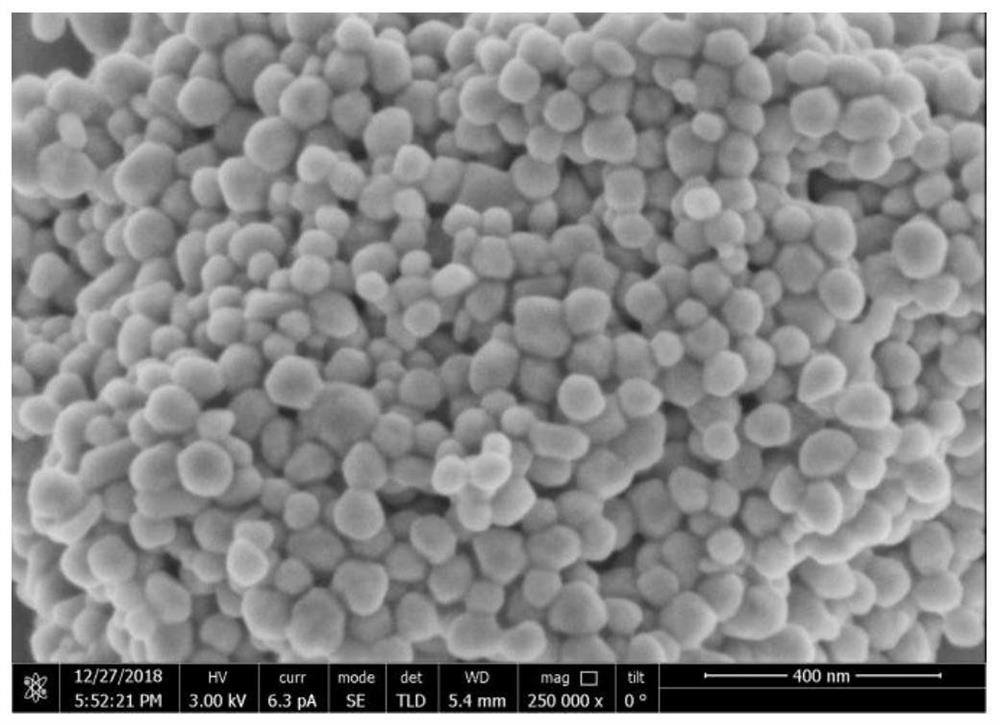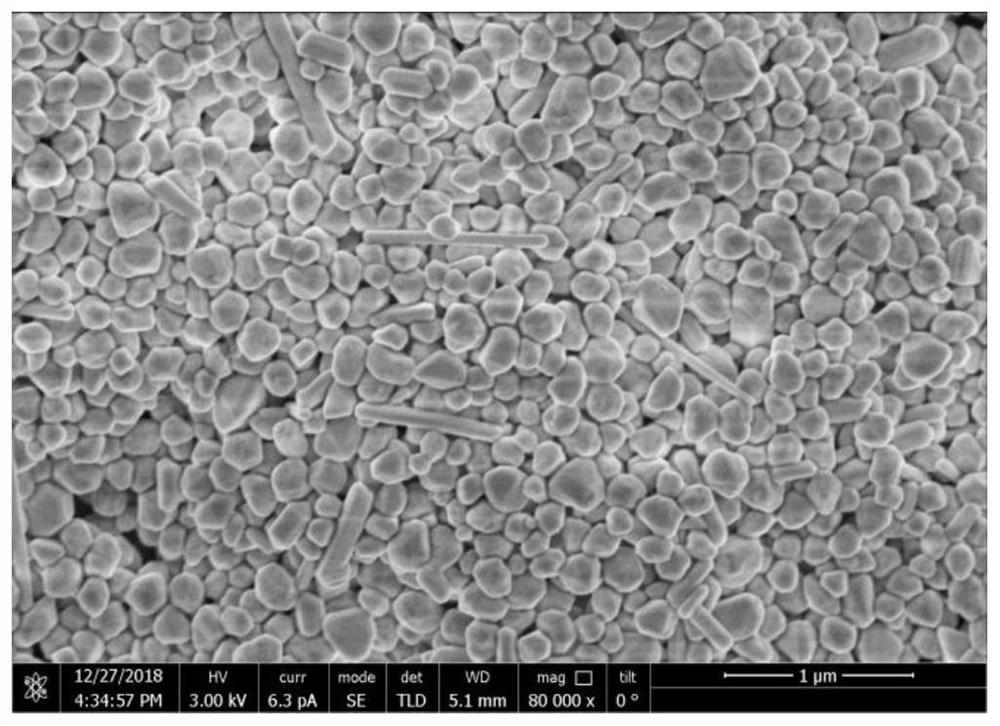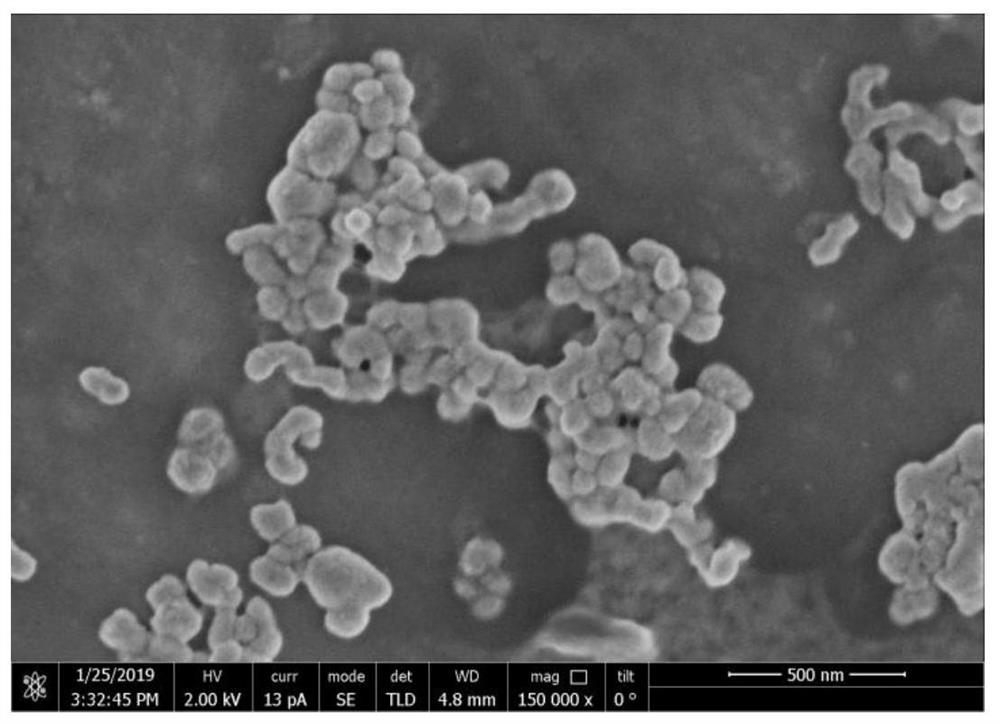A kind of nanometer copper and preparation method thereof
A technology of nano-copper and copper chloride dihydrate, applied in nanotechnology, nanotechnology, nanotechnology for materials and surface science, etc., can solve the problems of easy agglomeration of nano-copper particles, high production cost, long reaction time, etc. , to achieve the effect of favorable cleaning, less agglomeration and good dispersibility
- Summary
- Abstract
- Description
- Claims
- Application Information
AI Technical Summary
Problems solved by technology
Method used
Image
Examples
Embodiment 1
[0057] (1) Configure five solutions or reagents
[0058] a. Mix glycerol and deionized water in a volume ratio of 3:2 to form a reaction solution A;
[0059] b. Dissolve copper chloride dihydrate in solution A to form CuCl 2 Concentration is the reaction solution B of 0.02mol / L;
[0060] c. polyvinylpyrrolidone is dissolved in solution A to form a reaction solution C whose PVP concentration is 0.06mol / L;
[0061] d. Ascorbic acid is dissolved in solution A to form a reaction solution D whose concentration of ascorbic acid is 0.04mol / L;
[0062] e. Sodium hydroxide is dissolved in deionized water to form a sodium hydroxide reaction solution E with a concentration of 1mol / L;
[0063] (2) Take 30 mL of reaction solution C, add it dropwise to 30 mL of reaction solution D, and magnetically stir at 80° C. for 15 min to form mixed solution F. Take 20 mL of reaction solution B, add it dropwise to mixed solution F, and magnetically stir at 80°C for 15 min to form mixed solution G. ...
Embodiment 2
[0066] (1) Configure five solutions or reagents
[0067] a. Mix glycerol and deionized water in a volume ratio of 3:2 to form a reaction solution A;
[0068] b. Dissolve copper chloride dihydrate in solution A to form CuCl 2 Concentration is the reaction solution B of 0.02mol / L;
[0069] c. polyvinylpyrrolidone is dissolved in solution A to form a reaction solution C whose PVP concentration is 0.06mol / L;
[0070] d. Ascorbic acid is dissolved in solution A to form a reaction solution D whose concentration of ascorbic acid is 0.04mol / L;
[0071] e. Sodium hydroxide is dissolved in deionized water to form a sodium hydroxide reaction solution E with a concentration of 1mol / L;
[0072] (2) Take 30 mL of reaction solution C, add it dropwise to 30 mL of reaction solution D, and magnetically stir at 80° C. for 15 min to form mixed solution F. Take 20 mL of reaction solution B, add it dropwise to mixed solution F, and magnetically stir at 80°C for 15 min to form mixed solution G. ...
Embodiment 3
[0075] (1) Configure five solutions or reagents
[0076] a. Mix glycerol and deionized water in a volume ratio of 3:2 to form a reaction solution A;
[0077] b. Dissolve copper chloride dihydrate in solution A to form CuCl 2 Concentration is the reaction solution B of 0.02mol / L;
[0078] c. polyvinylpyrrolidone is dissolved in solution A to form a reaction solution C whose PVP concentration is 0.06mol / L;
[0079] d. Ascorbic acid is dissolved in solution A to form a reaction solution D whose concentration of ascorbic acid is 0.04mol / L;
[0080] e. Sodium hydroxide is dissolved in deionized water to form a sodium hydroxide reaction solution E with a concentration of 1mol / L;
[0081] (2) Take 30 mL of reaction solution C, add it dropwise to 30 mL of reaction solution D, and magnetically stir at 80° C. for 15 min to form mixed solution F. Take 20 mL of reaction solution B, add it dropwise to mixed solution F, and magnetically stir at 80°C for 15 min to form mixed solution G. ...
PUM
| Property | Measurement | Unit |
|---|---|---|
| diameter | aaaaa | aaaaa |
| particle diameter | aaaaa | aaaaa |
| diameter | aaaaa | aaaaa |
Abstract
Description
Claims
Application Information
 Login to View More
Login to View More - R&D
- Intellectual Property
- Life Sciences
- Materials
- Tech Scout
- Unparalleled Data Quality
- Higher Quality Content
- 60% Fewer Hallucinations
Browse by: Latest US Patents, China's latest patents, Technical Efficacy Thesaurus, Application Domain, Technology Topic, Popular Technical Reports.
© 2025 PatSnap. All rights reserved.Legal|Privacy policy|Modern Slavery Act Transparency Statement|Sitemap|About US| Contact US: help@patsnap.com



